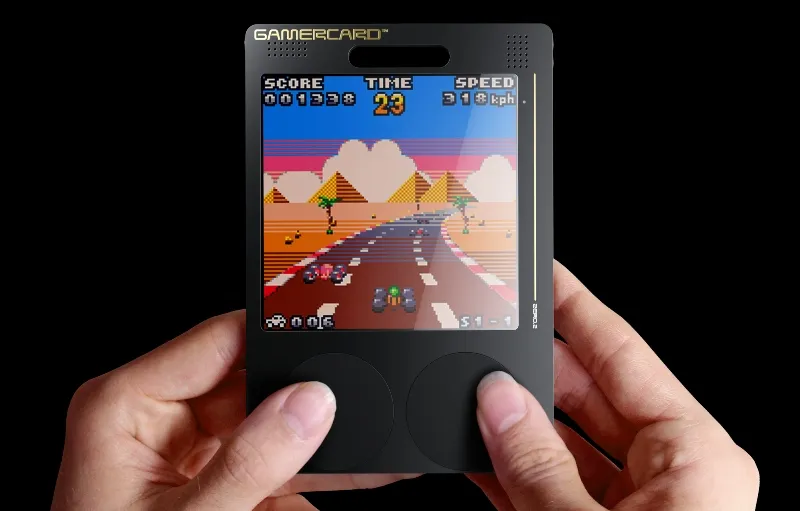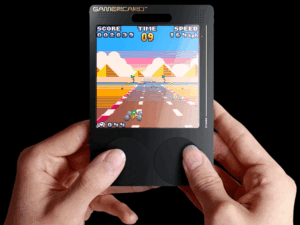Check out the creation of one Grant Sinclair, inventor of the IRIS eTrike. He’s also the nephew of the ZX Spectrum inventor, Sir Clive Sinclair.
GamerCard
We’re talking a quad-core Zero 2W board, combined with a hi-res 4″ square IPS display, along with stereo speakers. And yes, a battery is also compressed into the size and shape of a retail gift card. It’s described as “Grab and Go Raspberry Pi Gaming.”
“An integrated radiator heat sink ensures cool, stable overclocking of the processor whilst tactile snap-dome buttons and silicone navigation discs deliver arcade-style responsiveness,” writes Grant Sinclair.
Note that the ultra-thin passive heat sink radiator integrates into the device’s Zytel layer, sitting on top of the processor. And all its silicone control pads and buttons have anti-bacterial coating. Impressive stuff.
And did I mention the built-in Qwiic, USB-C, and HDMI ports, to make it more expandable…? See the video below.
Games pre-loaded
Two pre-loaded games are present, originally released by indie developers on the Nintendo Switch store. And they have now been adapted and optimized for GamerCard.
There’s Bloo Kid 2, an action game with levels, swimming stages, and boss battles, and AstroBlaze DX, a rhythm-based space shooter.
A Pi Game App will also be pre-installed giving users access to specially optimised Raspberry Pi games, created/modified exclusively for GamerCard’s square screen format. These include Saboteur – a trilogy of Ninja stealth action-adventure games created by Clive Townsend which are sold on the Nintendo Switch store and currently being updated for GamerCard.
Gift card
You can see why they call it a card. It’s ultra thin form factor makes it virtually the same dimensions as those gift-cards – for Apple, Google Play, Amazon and such like – that you see in supermarkets.
Pricing is £125 and the devices are now shipping worldwide (exclusively from grantsinclair.com). Note that the estimated for deliveries is 8-10 weeks.
“I conceived the idea for creating a gift card size gaming computer while browsing magazines in a WHSmith store, as I have since the 1980s,” said the device’s inventor Grant Sinclair.
“I was interested that Gift Cards are distributed in all categories of stores almost everywhere, usually positioned in prime location and selling in the billions of units – I thought this could be a really great way to make a computer available to the masses.”
Features
Note that the GamerCard is also capable of emulation. This is via emulator apps such as Recalbox, RetroPie, and Lakka (not included). In other words, giving access to a whole back-catalogue of classic games.
Apparently, it is also compatible with PICO-8 (for sale separately). This is the console app for making, playing and sharing mini retro-style games.
Grant Sinclair highlights that GamerCard’s 1:1 square display is a perfect match for PICO-8’s native resolution. Students can code, create and play full games within a single lesson, he says. This makes it a powerful, compact learning tool for game design, logic, and creative coding. You can then upload games to the PICO-8s Splore Game browser for everyone to enjoy and share worldwide.
Its makers say it is also fully programmable, supporting a range of coding environments, including MicroPython, C, C++, and BASIC
Technical Specification?
Weighing 100 grams, it measures 128 x 88 x 6.5mm (LxWxTh), and the device’s tech spec is below.
Processor
- Raspberry Pi Zero 2W
- 64-bit quad-core 1 GHz ARM Cortex-A53
- 512MB SDRAM
Display
- 4-inch IPS display (254 ppi, 60 fps) with sapphire glass protective layer
Storage
Connections
- Bluetooth 4.2 and Wi-Fi
- Expandable via HDMI for HDTV etc.
- USB-C for keyboard and mouse
- Qwiic port for breaking out and modifying
Power
- Built-in 1600 mAh Li-Po battery (rechargeable via USB-C)
- 3x micro LEDs for battery recharge status
Audio
- 2x sub-miniature loudspeakers,
- 2x monoblock amps with audio codec IC for stereo sound
Controls
- Front: 8x silicone control pads using tactile snap-dome micro push buttons
- Back: L+R silicone shoulder-style buttons with tactile snap-dome switches
- Silicone micro push buttons (START, SELECT, POWER-ON)
Images: GrantSinclair.com
See also: Arduino-based Ardu-Man recreates Pac-Man fun




